Hubble anniversary: 25 of the most beautiful images captured by Nasa's space telescope
The Hubble Space Telescope marks its 25th anniversary this week. Nasa wanted an observatory free of the atmosphere's distortion and light pollution, and sent Hubble into orbit on 24 April 1990, aboard space shuttle Discovery.
Excitement turned into agony when it quickly became apparent that the telescope's primary mirror had been botched during manufacturing, resulting in blurry "eyesight". Three years later, a team of astronauts managed to restore Hubble's vision with replacement parts.
Hubble has travelled 3.4 billion miles (5.5 billion km), circling Earth nearly 137,000 times and making more than 1.2 million observations of more than 38,000 celestial objects. The most distant objects spotted by Hubble – primitive galaxies – are some 13 billion light-years away and date to within 400 million or so years of the universe's origin, known as the Big Bang.
IBTimes UK celebrates Hubble's quarter-century in orbit with 25 of the best images captured by the space telescope.
This vibrant image of a giant cluster of about 3,000 stars called Westerlund 2has been released to celebrate Hubble's 25th year in orbit. The cluster resides in a raucous stellar breeding ground known as Gum 29, located 20 000 light-years away in the constellation Carina.
The stellar nursery is difficult to observe because it is surrounded by dust, but Hubble's Wide Field Camera 3 peered through the dusty veil in near-infrared light, giving astronomers a clear view of the cluster. Hubble's sharp vision resolves the dense concentration of stars in the central cluster, which measures only about 10 light-years across.
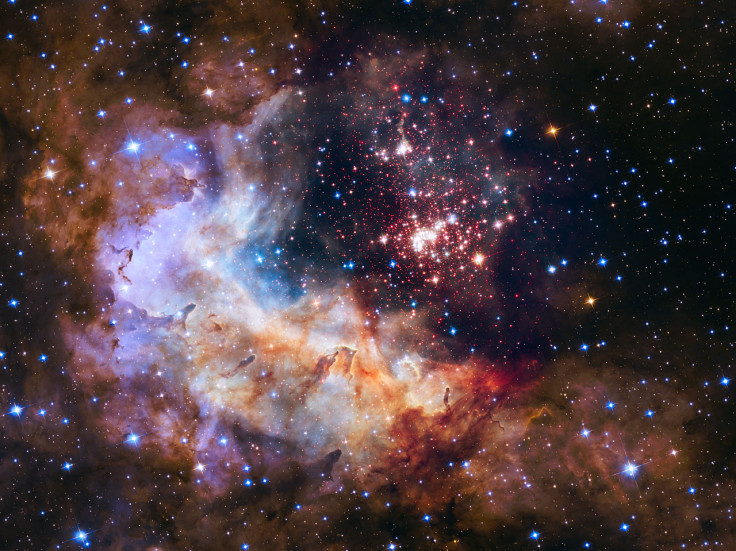
In January 2000, the space telescope snapped this picture of NGC 1999, a nebula in the constellation Orion. It is a reflection nebula. Like fog around a street lamp, a reflection nebula shines only because the light from an embedded source illuminates its dust; the nebula does not emit any visible light of its own.
The NGC 1999 nebula is illuminated by a bright, recently formed star, visible in the Hubble photo just to the left of centre. The star is so young that it is still surrounded by a cloud of material left over from its formation, here seen as the NGC 1999 reflection nebula.
This image of NGC 1999 shows a remarkable jet-black cloud, resembling a letter T tilted on its side. This dark cloud is an example of a "Bok globule", a cold cloud of gas, molecules, and cosmic dust, which is so dense it blocks all of the light behind it.
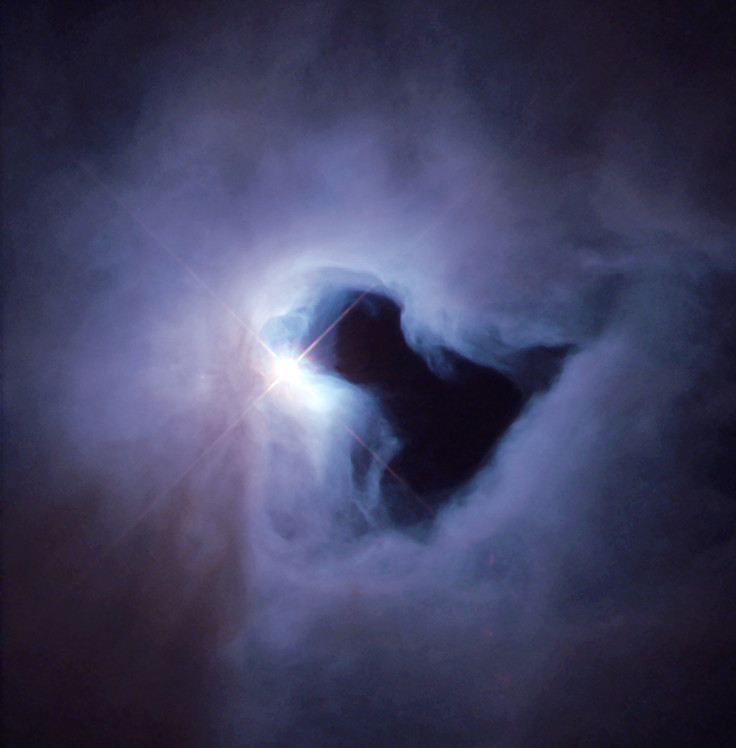
Spectacular jets are powered by the gravitational energy of a supermassive black hole in the core of the elliptical galaxy Hercules A.
The jets are very-high-energy plasma beams, subatomic particles and magnetic fields shot at nearly the speed of light from the vicinity of the black hole. The outer portions of both jets show unusual ring-like structures suggesting a history of multiple outbursts.
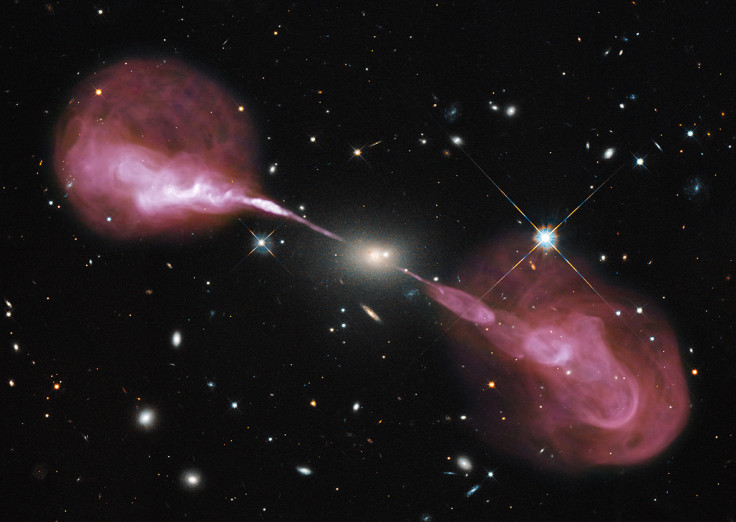
This faint cosmic whirl is the centre of lenticular galaxy NGC 524, located in the constellation of Pisces, some 90 million light-years from Earth.
Lenticular galaxies are believed to be an intermediate state in galactic evolution – they are neither elliptical nor spiral. Spirals are middle-aged galaxies with vast, pin wheeling arms that contain millions of stars. Along with these stars are large clouds of gas and dust that, when dense enough, are the nurseries where new stars are born.
When all the gas is either depleted or lost into space, the arms gradually fade away and the spiral shape begins to weaken. At the end of this process, what remains is a lenticular galaxy – a bright disc full of old, red stars surrounded by what little gas and dust the galaxy has managed to cling on to.
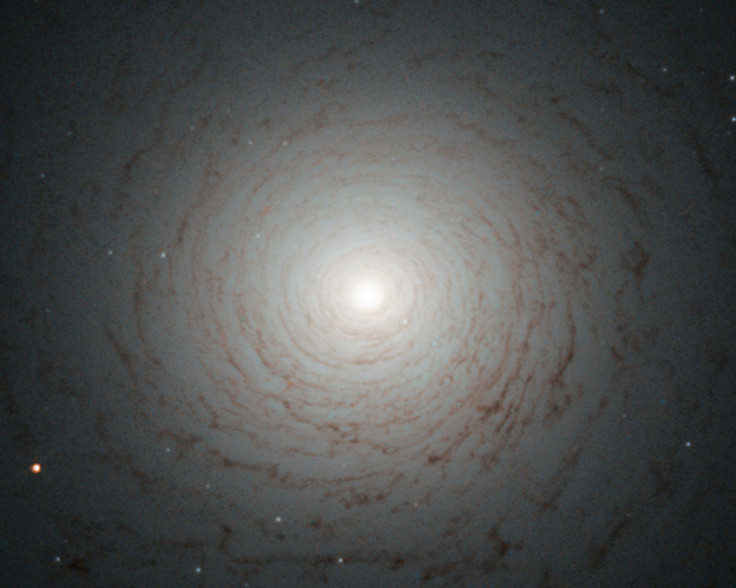
The tattered remains of a supernova explosion known as Cassiopeia A, the youngest known remnant from a supernova explosion in the Milky Way.
A supernova is the explosive demise of a massive star that collapses under the weight of its own gravity. The collapsed star then blows its outer layers into space in an explosion that can briefly outshine its entire parent galaxy. Cas A is relatively young, estimated to be only about 340 years old.
Hubble's razor-sharp images can observe the expansion of the remnant. A faint stream of debris seen along the upper left side of the remnant is moving with high speed – up to 31 million miles per hour (fast enough to travel from Earth to the Moon in 30 seconds!).
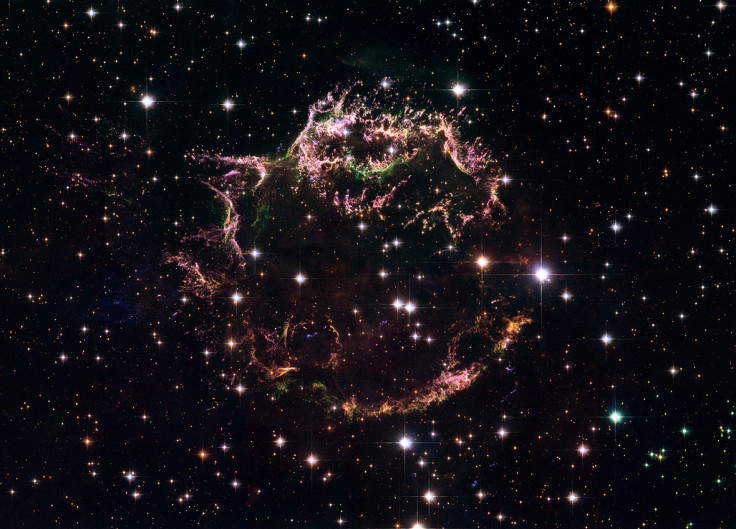
This Hubble telescope snapshot of MyCn18, a young planetary nebula, reveals that the object has an hourglass shape with an intricate pattern of "etchings" in its walls. A planetary nebula is the glowing relic of a dying, Sun-like star.
The results are of great interest because they shed new light on the poorly understood ejection of stellar matter that accompanies the slow death of stars. According to one theory on the formation of planetary nebulae, the hourglass shape is produced by the expansion of a fast stellar wind within a slowly expanding cloud, which is denser near its equator than near its poles.

A very small, faint galaxy – possibly one of the "building blocks" of present-day galaxies – was discovered at a tremendous distance of 13.4 billion light-years (consider that the universe is estimated to be 14 billion years old). The discovery was made possible by examining small areas of the sky viewed through massive intervening clusters of galaxies.
The gravitational field from this huge concentration of matter distorts and magnifies the light from distant galaxies. Gravitational lenses, the equivalent of nature's magnifying glasses in space, give researchers a unique tool with which to learn more about the detailed physics of the first galaxies in the universe.

Dubbed the Spirograph Nebula, IC 418 shows patterns that are not well understood. Perhaps they are related to chaotic winds from the variable central star, which changes brightness unpredictably in just a few hours.
Only a few thousand years ago, IC 418 was probably a common red giant star. Since running out of nuclear fuel, though, the outer envelope has begun expanding outward leaving a hot remnant core destined to become a white-dwarf star. The light from the central core excites surrounding atoms in the nebula causing them to glow.
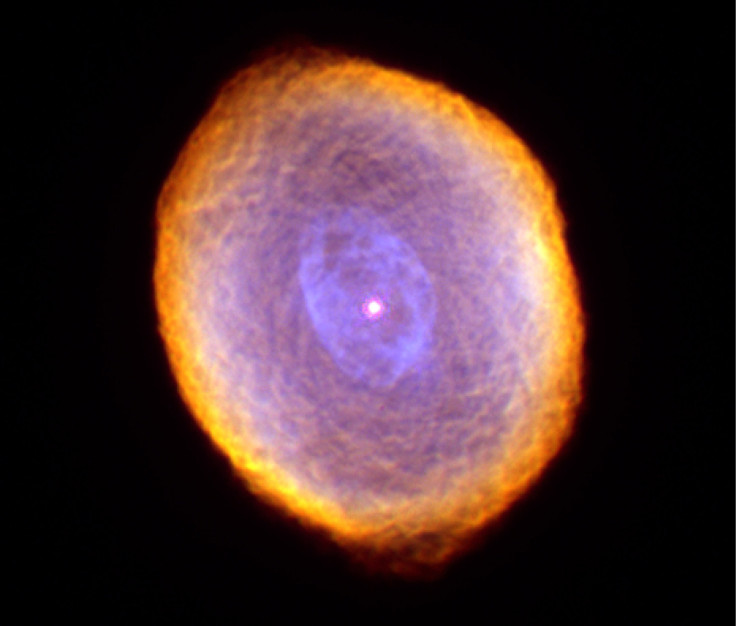
The disk galaxy NGC 5866 is viewed tilted nearly edge-on to our line of sight. Viewed face on, it would look like a smooth, flat disc with little spiral structure.
Hubble's sharp vision reveals a crisp dust lane dividing the galaxy into two halves. The image highlights the galaxy's structure: a subtle, reddish bulge surrounding a bright nucleus, a blue disk of stars running parallel to the dust lane, and a transparent outer halo.
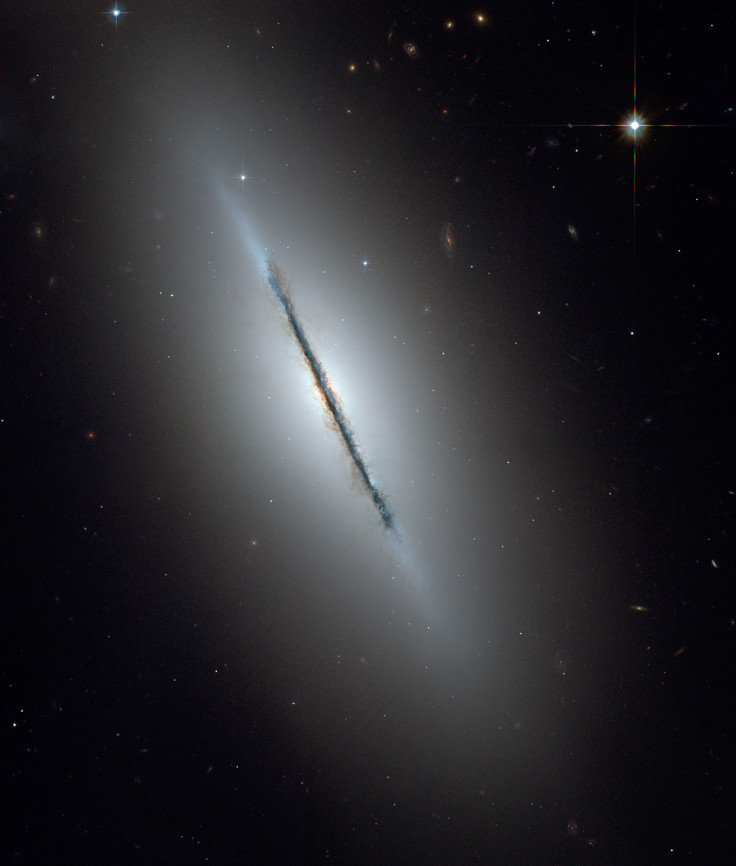
Stephan's Quintet, as the name implies, is a group of five galaxies. Three of the galaxies have distorted shapes, elongated spiral arms, and long, gaseous tidal tails containing myriad star clusters, proof of their close encounters. These interactions have sparked a frenzy of star birth in the central pair of galaxies.
The colours trace the ages of the stellar populations, from young, blue stars to aging, red stars, showing that star birth occurred at different epochs, stretching over hundreds of millions of years.
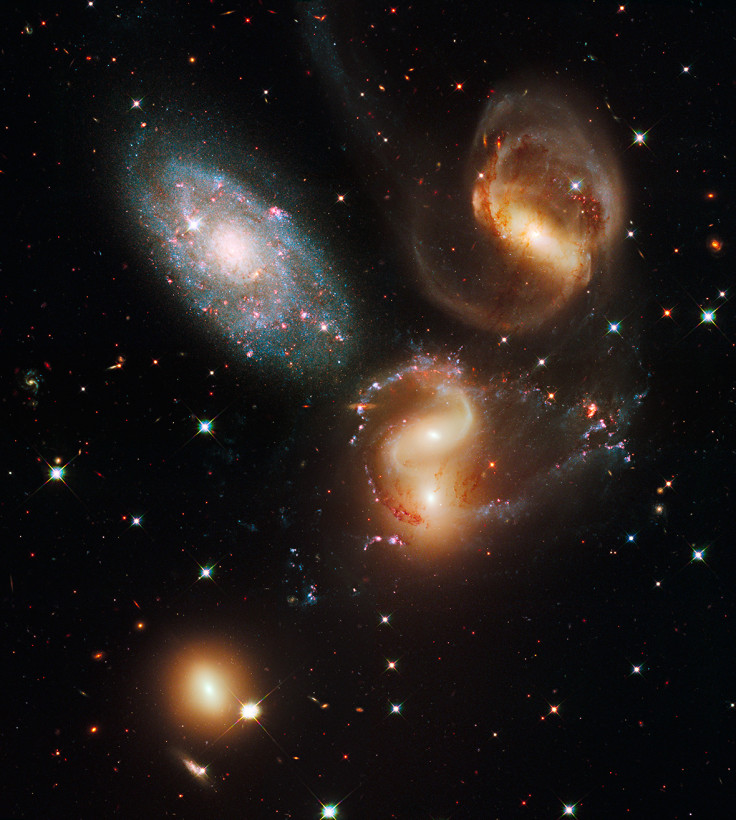
This craggy mountaintop enshrouded by wispy clouds looks like a fantasy landscape from Tolkien's The Lord Of The Rings.
The image captures the chaotic activity atop a three-light-year-tall pillar of gas and dust that is being eaten away by the brilliant light from nearby bright stars. The pillar is also being assaulted from within, as infant stars buried inside it fire off jets of gas that can be seen streaming from towering peaks.
This turbulent cosmic pinnacle lies within a stellar nursery called the Carina Nebula, located 7,500 light-years away in the southern constellation Carina.
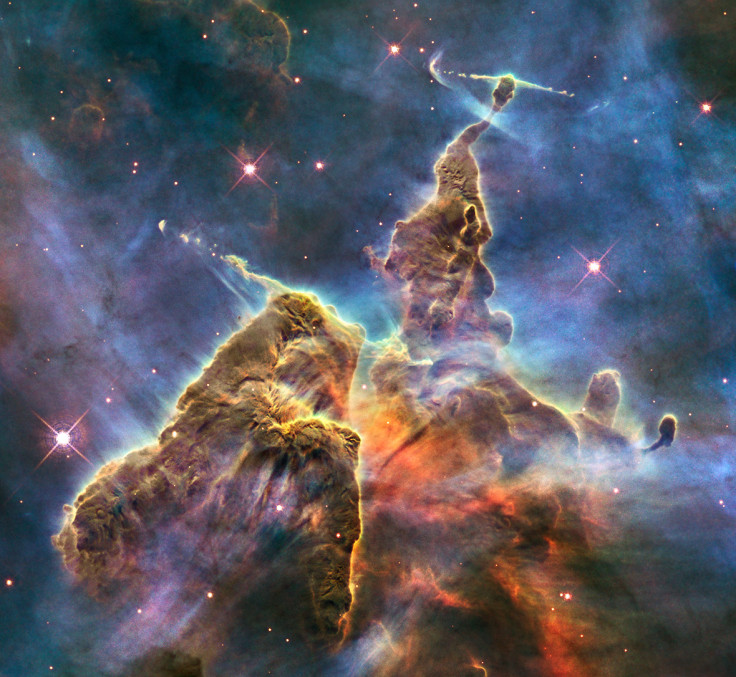
Hubble bubble: This image of supernova remnant 0509-67.5 shows soft green and blue hues of heated material surrounded by a glowing pink shell, which shows the ambient gas being shocked by the expanding blast wave from the supernova.
The supernova that resulted in the creation of SNR 0509-67.5 occurred nearly 400 years ago for Earth viewers. The bubble-shaped shroud of gas is 23 light-years across and is expanding at more than 11 million miles per hour (5,000km per second).
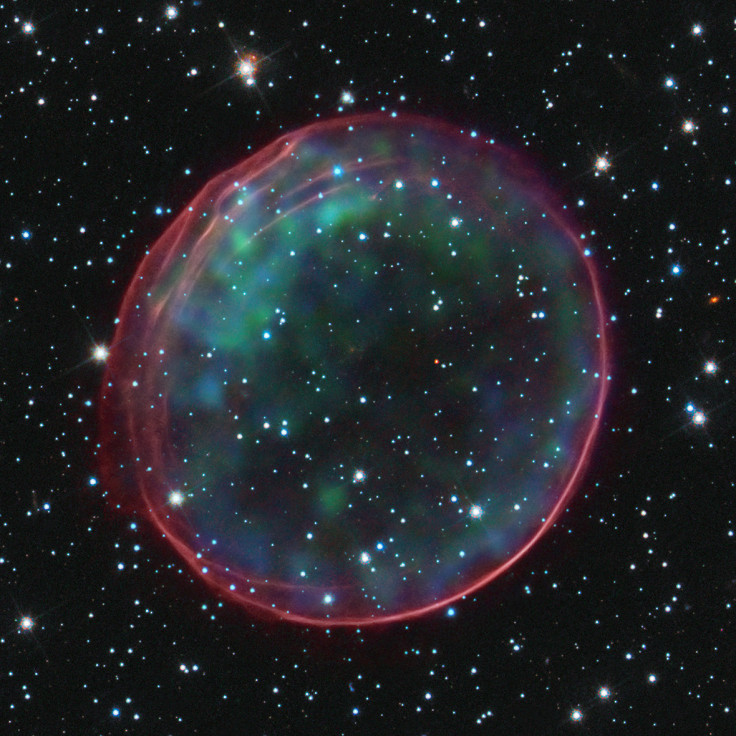
This celestial object looks like a delicate butterfly. But it is far from serene. What resemble dainty butterfly wings are actually roiling cauldrons of gas heated to more than 36,000 degrees Fahrenheit (19,982C). The gas is tearing across space at more than 600,000 miles an hour.
A dying star that was once about five times the mass of the Sun is at the centre of this fury. NGC 6302 has ejected its envelope of gases and is now unleashing a stream of ultraviolet radiation that is making the cast-off material glow. This object is an example of a planetary nebula, so-named because many of them have a round appearance resembling that of a planet when viewed through a small telescope.
The "butterfly" stretches for more than two light-years, which is about half the distance from the Sun to the nearest star, Alpha Centauri.

Hubble revisited its famous Pillars of Creation, revealing a sharper and wider view of the structures in this visible-light image.
The towering pillars are about five light-years tall and are bathed in the blistering ultraviolet light from a grouping of young, massive stars located off the top of the image. Streamers of gas can be seen bleeding off the pillars as the intense radiation heats and evaporates it into space.
Denser regions of the pillars are shadowing material beneath them from the powerful radiation. Stars are being born deep inside the pillars, which are made of cold hydrogen gas laced with dust. The pillars are part of a small region of the Eagle Nebula, a vast star-forming region 6,500 light-years from Earth.
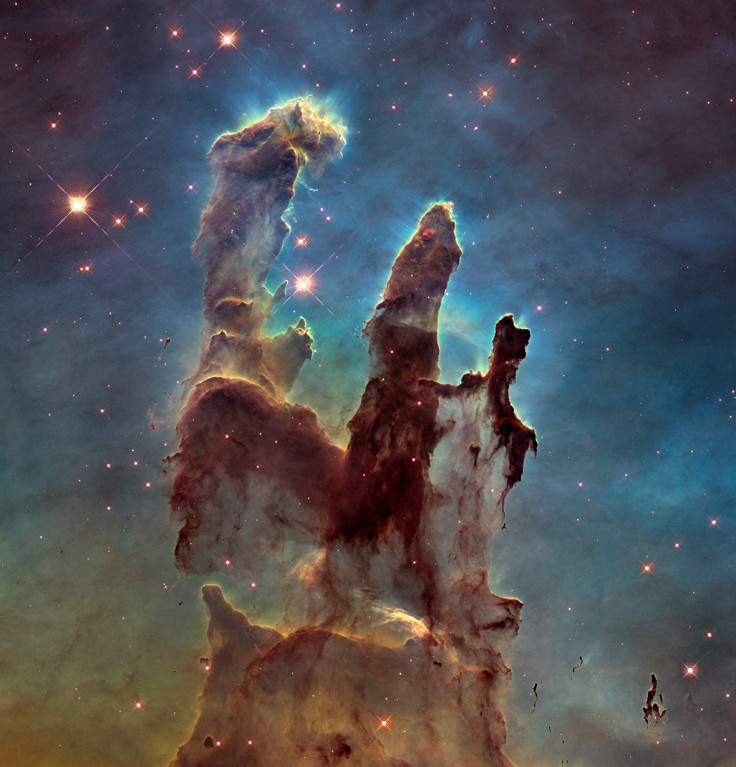
Hubble photographed a nearby planetary nebula called NGC 5189. While consuming the last of the fuel in its core, the dying star expels a large portion of its outer envelope. This material then becomes heated by the radiation from the stellar remnant and radiates, producing glowing clouds of gas that can show complex structures, as the ejection of mass from the star is uneven in both time and direction.
As a result of the mass-loss process, the planetary nebula has been created with two nested structures, tilted with respect to each other, that expand away from the centre in different directions.
The remnant of the central star, having lost much of its mass, now lives its final days as a white dwarf.
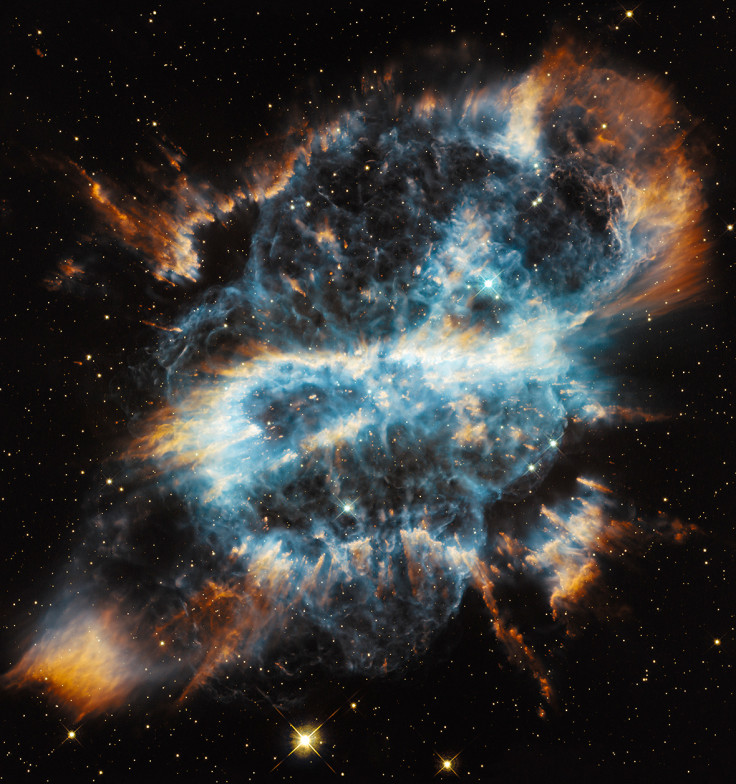
Hubble photographed a group of interacting galaxies called Arp 273. The larger of the spiral galaxies, known as UGC 1810, has a disk that is distorted into a rose-like shape by the gravitational tidal pull of the companion galaxy below it, known as UGC 1813.
This smaller, nearly edge-on companion shows distinct signs of intense star formation at its nucleus, perhaps triggered by the encounter with the companion galaxy.

This giant spiral disc of stars, dust, and gas is 170,000 light-years across or nearly twice the diameter of the Milky Way. Nicknamed the Pinwheel Galaxy, M101 is estimated to contain at least one trillion stars. Approximately 100 billion of these stars could be like our Sun in terms of temperature and lifetime.
The galaxy's spiral arms are sprinkled with large regions of star-forming nebulae. Brilliant young clusters of hot, blue, newborn stars trace out the spiral arms. The disc of M101 is so thin that Hubble easily sees many more distant galaxies lying behind the galaxy.

The Cat's Eye Nebula looks like the penetrating eye of the disembodied sorcerer Sauron from The Lord Of The Rings film.
Although the nebula, NGC 6543, was one of the first planetary nebulae to be discovered, it is one of the most complex such nebulae ever seen.
This Hubble image reveals a bull's eye pattern of eleven or more concentric rings, or shells, around the Cat's Eye. Each 'ring' is actually the edge of a spherical bubble seen projected onto the sky. Observations suggest the star ejected its mass in a series of pulses at 1,500-year intervals.
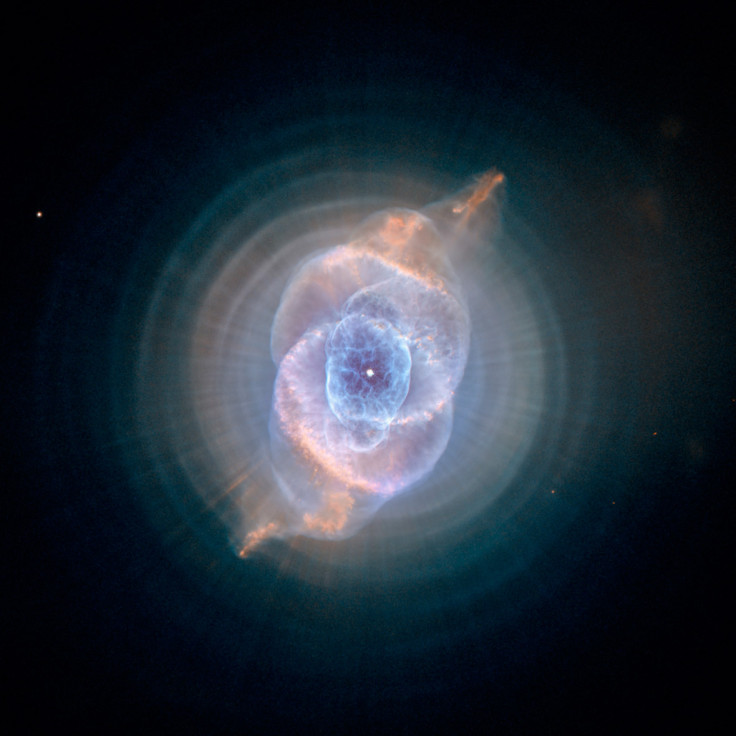
An expanding halo of light is seen around a distant star, named V838 Monocerotis (V838 Mon). The illumination of interstellar dust comes from the red supergiant star at the middle of the image, which gave off a flashbulb-like pulse of light in 2002.
The Hubble telescope has imaged V838 Mon and its light echo several times since the star's outburst in January 2002, in order to follow the constantly changing appearance of the dust as the pulse of illumination continues to expand away from the star at the speed of light.
During the outburst event, the normally faint star suddenly brightened, becoming 600,000 times more luminous than our Sun. It was thus one of the brightest stars in the entire Milky Way, until it faded away again in April 2002.
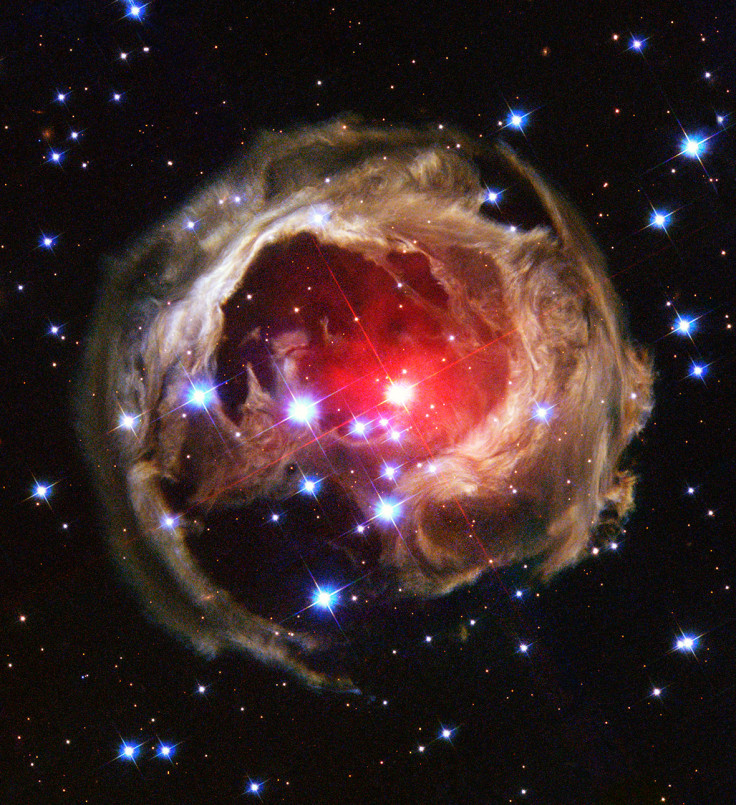
This image shows a fine web of filamentary "bicycle-spoke" features embedded in the red and blue gas ring of the Helix Nebula, which is one of the nearest planetary nebulae to Earth.
The image offers a dizzying look down what is actually a trillion-mile-long tunnel of glowing gases. The fluorescing tube is pointed nearly directly at Earth, so it looks more like a bubble than a cylinder. A forest of thousands of comet-like filaments, embedded along the inner rim of the nebula, points back toward the central star, which is a small, super-hot white dwarf.

A nearly perfect ring of hot, blue stars pinwheels about the yellow nucleus of an unusual galaxy known as Hoag's Object.
The blue ring, which is dominated by clusters of young, massive stars, contrasts sharply with the yellow nucleus of mostly older stars. Ring-shaped galaxies can form in several different ways. One possible scenario is through a collision with another galaxy. Sometimes the second galaxy speeds through the first, leaving a "splash" of star formation.
But in Hoag's Object there is no sign of the second galaxy, which leads to the suspicion that the blue ring of stars may be the shredded remains of a galaxy that passed nearby. Some astronomers estimate that the encounter occurred about two to three billion years ago.
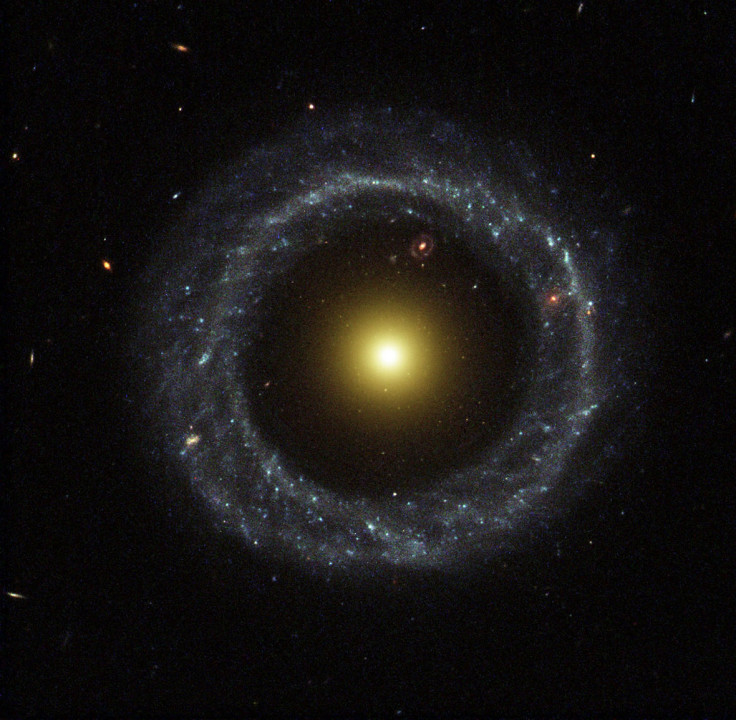
The Cone Nebula (NGC 2264) is giant pillar in a turbulent star-forming region 2,500 light-years away in the constellation Monoceros.
Radiation from hot, young stars has slowly eroded the nebula over millions of years. Ultraviolet light heats the edges of the dark cloud, releasing gas into the relatively empty region of surrounding space.
Over time, only the densest regions of the Cone will be left. Inside these regions, stars and planets may form.
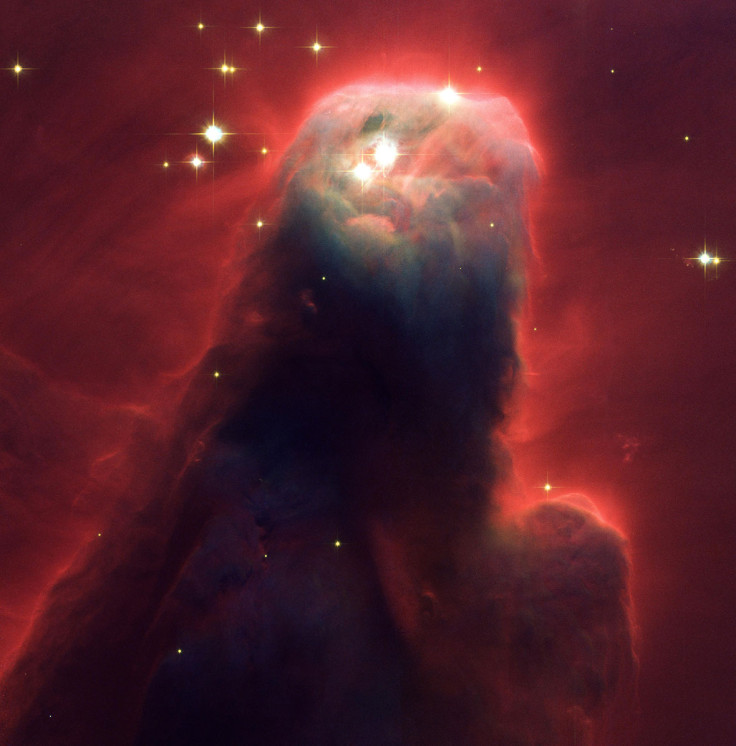
The Horsehead Nebula, normally shadowy in optical light, appears transparent and ethereal when seen in infrared.
The backlit wisps along the Horsehead's upper ridge are being illuminated by Sigma Orionis, a young five-star system just off the top of the Hubble image.
Gas clouds surrounding the Horsehead have already dissipated, but the tip of the jutting pillar contains a slightly higher density of hydrogen and helium, laced with dust. Astronomers estimate that the Horsehead formation has about five million years left before it too disintegrates.
The Horsehead Nebula is part of a much larger complex in the constellation Orion. At about 1,500 light-years away, this complex is one of the nearest and most easily photographed regions in which massive stars are being formed.
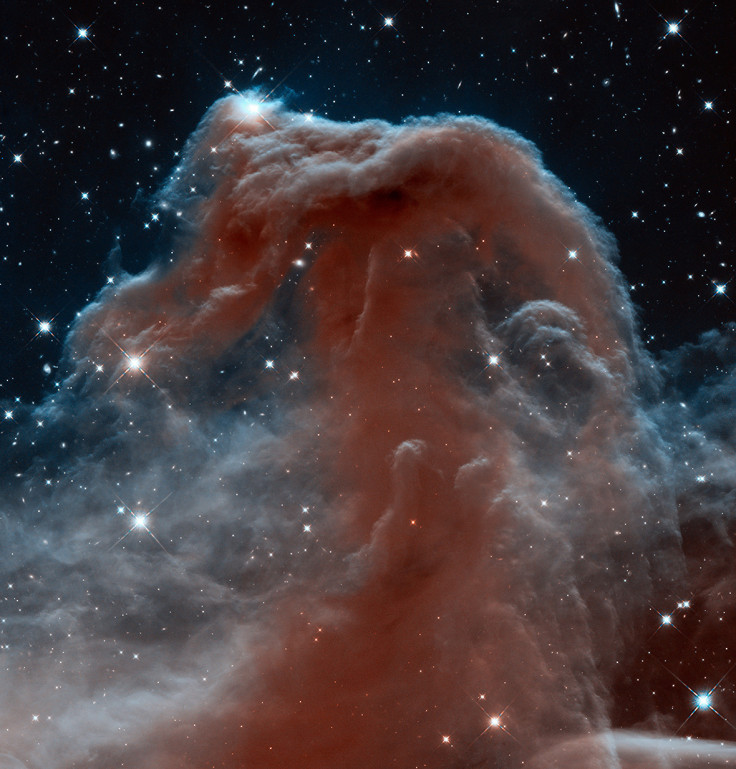
This remarkable image, called the eXtreme Deep Field (XDF), was assembled by combining 10 years of Hubble photographs taken of a patch of sky at the centre of the original Hubble Ultra Deep Field.
The Hubble Ultra Deep Field is an image of a small area of space in the constellation Fornax, created using Hubble data from 2003 and 2004. By collecting faint light over many hours of observation, it revealed thousands of galaxies, both nearby and very distant, making it the deepest image of the universe ever taken at that time.
The new full-colour XDF image image is even more sensitive and contains about 5,500 galaxies. The faintest are one ten-billionth the brightness of what the human eye can see.
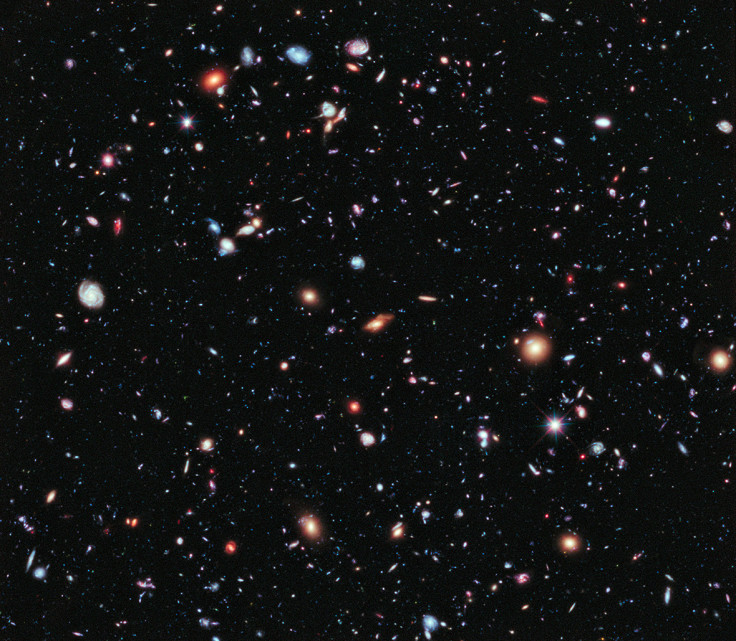
Messier 104 (M104) was named the Sombrero galaxy because of its resemblance to the broad rim and high-topped Mexican hat.
As seen from Earth, the galaxy is tilted nearly edge-on. The galaxy is 50,000 light-years across and is located 28 million light-years from Earth.

Hubble's successor, the James Webb Space Telescope, is due to be launched in 2018 to a vantage point one million miles (1.6 million km) away.
The Webb will specialise in the infrared wavelength, allowing it to peer into some of the faintest, most distant recesses of the universe. This should enable the telescope to look back even farther in time than Hubble and detect galaxies formed a mere 200 million years following the Big Bang.
© Copyright IBTimes 2025. All rights reserved.






















